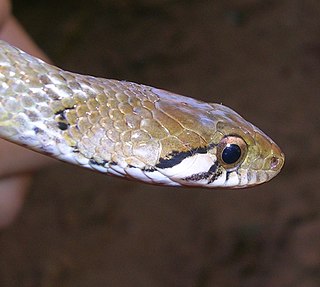
The Nilgiri keelback, also known commonly as Beddome's keelback, is a species of snake found in the Western Ghats in India. The species is named after Richard Henry Beddome, 1830–1911, British army officer and naturalist. It was first discovered near the Nilgiris but is now known more widely from the Western Ghats. This snake is terrestrial and feeds on toads.
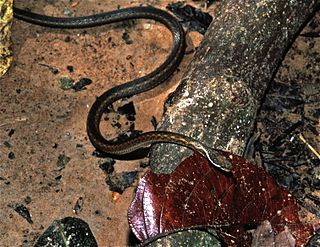
Hebius khasiensis, commonly known as the Khasi Hills keelback or Khasi keelback, is a species of colubrid snake endemic to southeastern Asia.
Hebius modestus, commonly known as the modest keelback or Günther's keelback, is a species of natricine snake endemic to Asia.
The Yunnan keelback is a species of natricine snake which is endemic to Asia.
The Assam keelback, commonly known as Peal's keelback, is a species of snake in the subfamily Natricinae of the family Colubridae. The species is endemic to Northeast India. It has recently been rediscovered after 129 years in Arunachal Pradesh.

The Himalayan keelback is a species of grass snake in the family Colubridae. The species is endemic to South Asia.
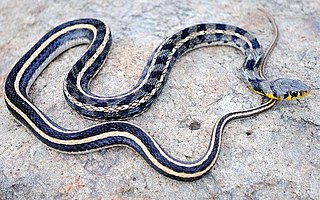
The buff striped keelback is a species of nonvenomous colubrid snake found across Asia. It is a typically non-aggressive snake that feeds on frogs and toads. It belongs to the subfamily Natricinae, and is closely related to water snakes and grass snakes. It resembles an Asian version of the American garter snake. It is quite a common snake but is rarely seen.
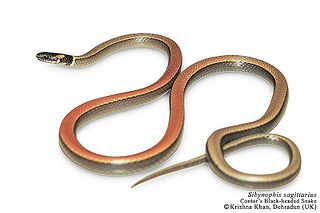
Sibynophis sagittarius, commonly known as Cantor's black-headed snake after Theodore Cantor, is a species of snake endemic to South Asia.
Uropeltis myhendrae, commonly known as Boulenger's earth snake, the Mahendragiri earth snake, and the Myhendra Mountain uropeltis, is a species of snake in the family Uropeltidae. The species is endemic to India.

Hydrophis melanocephalus, commonly known as the slender-necked sea snake, is a species of venomous sea snake in the family Elapidae.

Günther's black snake is a species of poorly known lamprophiid snake endemic to central Africa. It is the only member of the genus, Bothrolycus. This snake is notable as one of the few snakes with notable sexual dimorphism, as well as possessing a small pit anterior to the eye. While superficially similar to the thermal pits of vipers, its function remains unknown.

The crayfish snake, also known commonly as the glossy crayfish snake, the glossy swampsnake, the glossy water snake, and the striped water snake, is a species of semiaquatic snake in the subfamily Natricinae of the family Colubridae. The species is endemic to the southeastern United States, and preys mainly on crayfish.
The Sabah keelback is a nonvenomous colubrid endemic to Borneo.
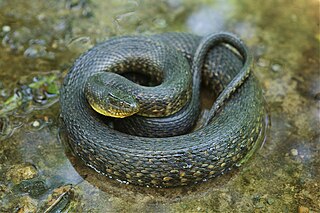
The green water snake is a common species of nonvenomous natricine snake endemic to the southeastern United States.
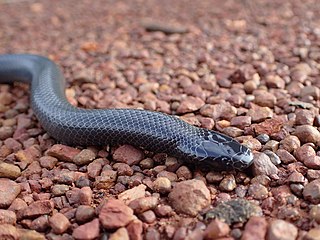
Atractaspis congica, commonly known as the Congo burrowing asp, is a species of venomous snake in the family Atractaspididae. It is found in Africa.

Aparallactus lunulatus, or the reticulated centipede-eater, is a species of mildly venomous rear-fanged snake in the family Atractaspididae, which is endemic to Africa.
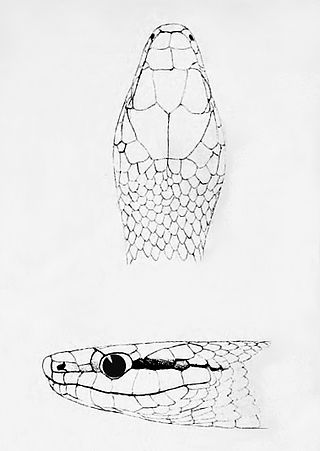
Leptophis modestus, commonly known as the cloud forest parrot snake, is a species of medium-sized slender snake of the family Colubridae. It is endemic to Mesoamerica. There are currently no recognized subspecies.
Rhabdophis ceylonensis is endemic to the island of Sri Lanka. The species is commonly known as the Sri Lanka blossom krait, the Sri Lanka keelback, and මල් කරවලා or නිහලුවා (nihaluwa) in Sinhala. It is a moderately venomous snake.
Aspidura copei, commonly known as Cope's rough-sided snake or කලු මැඩිල්ලා in Sinhalese, is a species of snake in the family Colubridae. The species is endemic to Sri Lanka.
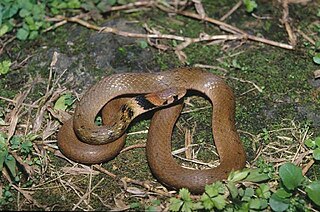
Rhabdophis swinhonis is a species of snake in the subfamily Natricinae of the family Colubridae. The species is endemic to Taiwan. It is also known commonly as the Taiwan keelback and Swinhoe's grass snake.














